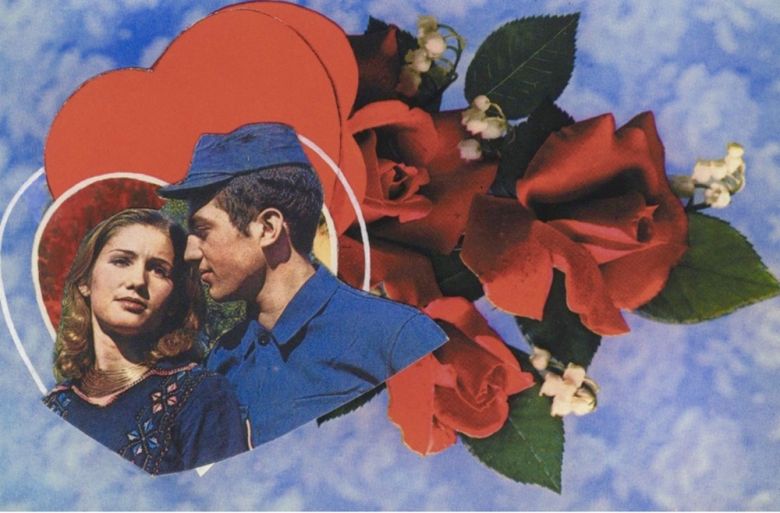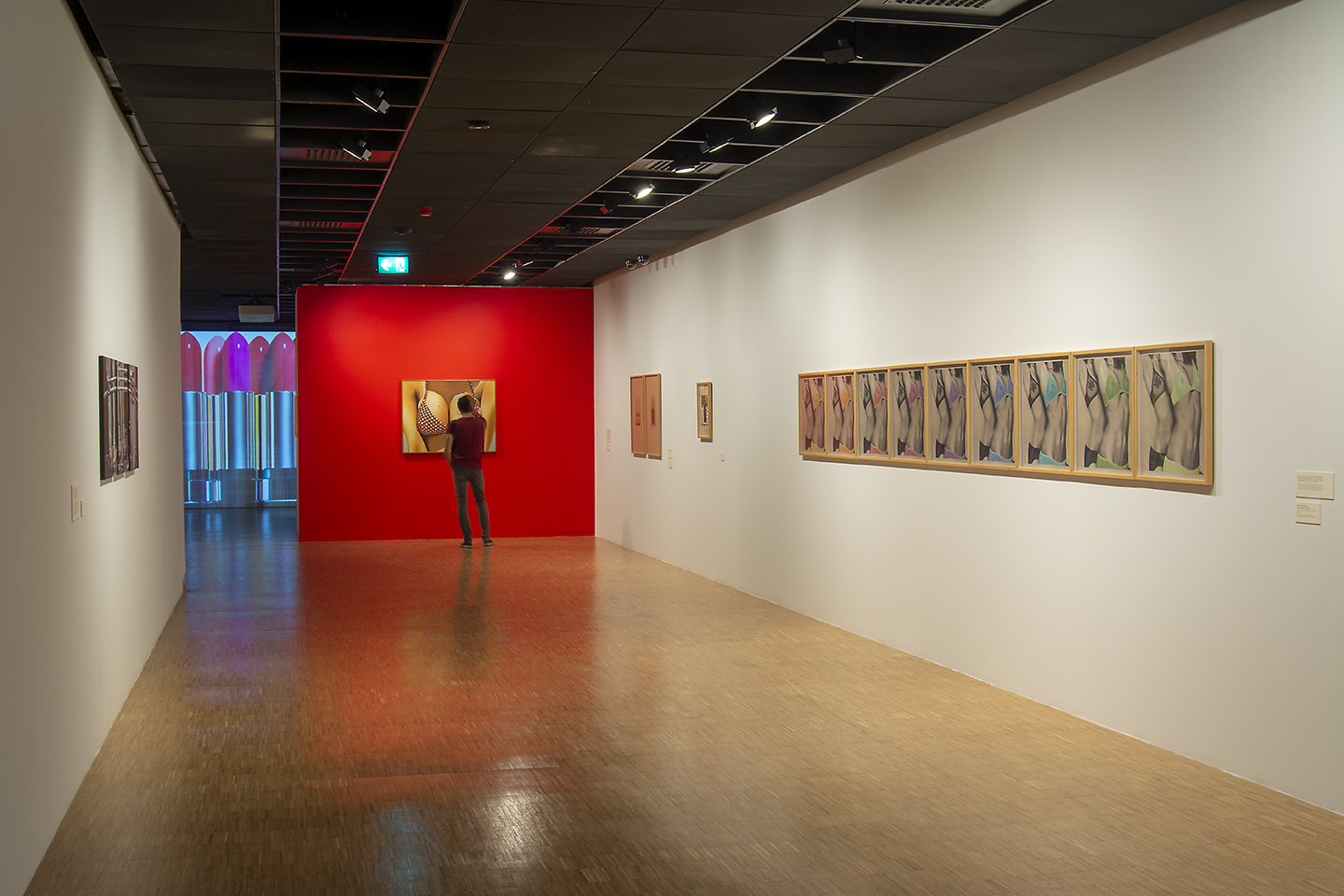Our Blissful Souvenirs
Nur Koçak
Salt Beyoğlu, Salt Galata
September 3 – December 29, 2019

Nur Koçak, a postcard from the series Müdahale Edilmiş Kartpostallar [Manipulated Postcards], 1981
Courtesy the artist
Courtesy the artist
The most comprehensive exhibition to date of Nur Koçak, one of Turkey’s first photorealist painters, is presented at SALT Beyoğlu and SALT Galata. Titled after one of her works, Our Blissful Souvenirs comprises a selection of early drawings and photographic series, produced between the 1960s and 2010s. The exhibition offers an in-depth view into Koçak’s critically narrative practice, which examines the spread of popular culture from women’s magazines and Hollywood movies through to its repercussions in Turkey.
Our Blissful Souvenirs begins at SALT Beyoğlu’s ground floor, with the Vitrinler [Shop Windows] (1989-2019) series installed in the Forum. These photographs and paintings focus on the reflections of the global consumer culture on various shop windows in central Istanbul, questioning the depersonalization of the female body, as it suddenly became the object of the gaze through the overt display of retail products once deemed private. The presentation also reinstates Ebrusan Vitrini [Ebrusan Shop Window] (1993-1996) to Beyoğlu more than a quarter century later, in which fishnet stockings embroidered with beads or rhinestones, lace lingerie and other accessories are intertwined with street images.
In the series Fetiş Nesneler [Fetish Objects] (1974-1988) and Nesne Kadınlar [Object Women] (1975-1979), located on the third floor, Koçak uses visual elements from the women’s magazines she followed in Paris while studying painting. Beginning with her 1974 work Vivre–defined by the artist as the turning point of her practice–Fetish Objects decontextualizes and monumentalizes alluring photographs of popular nail polish, lipstick and perfume brands by transferring them onto canvas. In works such as Kırmızı ve Siyah [Red and Black] (1976) and Hommage à Vasarely (1977) from Object Women, Koçak depicts “anonymous” women as faceless bodies, using images from underwear, swimwear and bikini advertisements.
The only female figure that the artist did not anonymize as an “object of desire” in her work was the actress and filmmaker Cahide Sonku (1919-1981), also known as the first female film star in Turkey. With her independent stance and her Hollywood-style blonde hair, she quickly became a representational figure for the collective desire to “Westernize.” In the series Cahide’nin Öyküsü [The Story of Cahide] (1996-2006), Koçak uses photographs from theater plays as well as film stills to examine the tastes of the pre-1960 urban middle class while scrutinizing the ways Sonku was discredited through the foregrounding of her tumultuous life rather than her professional output.
In the multiple series on the second floor of SALT Beyoğlu, Koçak weaves together her childhood memories with scenes of happiness etched into the collective psyche. Aile Albümü [Family Album] (1979-2012) is based on photographs, mostly taken in a studio, of the artist’s own family, ranging from the time her parents got married in 1930 to the 1950s. Daughter of a military officer, Koçak probes the image of the ideal family of the republic, in which each member is assigned a strictly defined role; the uniformed father stresses the firm institutionalization of the family, the devoted mother stands in for support and continuity while the carefully dressed children signify a hopeful future.
The series Mutluluk Resimleriniz [Your Blissful Souvenirs] (1981) renders visible the extensive use of postcards as an artistic medium in Koçak’s practice, after she began participating in mail-art exhibitions at the end of the 1970s. In these works, she appropriates romanticized postcards of soldiers doing their mandatory military service, found in Istanbul’s printing district Cağaloğlu. They are accompanied by black and white drawings based on a column titled “Your Blissful Souvenirs” in Kelebek, a popular women’s newspaper of the time. The juxtaposition that Koçak makes between the postcards that feature both men and women with the male-only photographs printed in the column draw attention to the discrepancy between an experience and its representation. The installation at SALT Beyoğlu allows for both sides of the postcards to be seen for the first time since the work’s initial display in 1982.
Opposing the strict rules set forth by her academic training, Koçak insisted on making photorealist paintings early on in her career. Her determination in this preferred technique and medium, as well as the feminist viewpoint that continues to inform her practice today, helped transform the local art historical narratives that often overlooked or entirely disregarded female identity. Born in 1941, Koçak made her foray into art early on; in primary school she studied under the tutelage of artist Turgut Zaim at TED Ankara College Foundation School. In high school, she studied with abstract expressionist painter Leon Berkowitz in Washington, DC, where she was chosen “the best student in painting.” During her education at the State Academy of Fine Arts in Istanbul, which she started in 1960, Koçak first joined Adnan Çoker’s gallery, and later the studios of Cemal Tollu and Neşet Günal. The drawings she made until her move to France in 1970 when she won a scholarship from the Ministry of Education of the Republic of Turkey are exhibited at SALT Galata. This final part of the exhibition exemplifies sketches and studies from that decade, reflecting the drawing-based approach dominant in art education at the Academy at the time.
Our Blissful Souvenirs was programmed by art historian Ahu Antmen together with Amira Akbıyıkoğlu from SALT.
Our Blissful Souvenirs begins at SALT Beyoğlu’s ground floor, with the Vitrinler [Shop Windows] (1989-2019) series installed in the Forum. These photographs and paintings focus on the reflections of the global consumer culture on various shop windows in central Istanbul, questioning the depersonalization of the female body, as it suddenly became the object of the gaze through the overt display of retail products once deemed private. The presentation also reinstates Ebrusan Vitrini [Ebrusan Shop Window] (1993-1996) to Beyoğlu more than a quarter century later, in which fishnet stockings embroidered with beads or rhinestones, lace lingerie and other accessories are intertwined with street images.
In the series Fetiş Nesneler [Fetish Objects] (1974-1988) and Nesne Kadınlar [Object Women] (1975-1979), located on the third floor, Koçak uses visual elements from the women’s magazines she followed in Paris while studying painting. Beginning with her 1974 work Vivre–defined by the artist as the turning point of her practice–Fetish Objects decontextualizes and monumentalizes alluring photographs of popular nail polish, lipstick and perfume brands by transferring them onto canvas. In works such as Kırmızı ve Siyah [Red and Black] (1976) and Hommage à Vasarely (1977) from Object Women, Koçak depicts “anonymous” women as faceless bodies, using images from underwear, swimwear and bikini advertisements.
The only female figure that the artist did not anonymize as an “object of desire” in her work was the actress and filmmaker Cahide Sonku (1919-1981), also known as the first female film star in Turkey. With her independent stance and her Hollywood-style blonde hair, she quickly became a representational figure for the collective desire to “Westernize.” In the series Cahide’nin Öyküsü [The Story of Cahide] (1996-2006), Koçak uses photographs from theater plays as well as film stills to examine the tastes of the pre-1960 urban middle class while scrutinizing the ways Sonku was discredited through the foregrounding of her tumultuous life rather than her professional output.
In the multiple series on the second floor of SALT Beyoğlu, Koçak weaves together her childhood memories with scenes of happiness etched into the collective psyche. Aile Albümü [Family Album] (1979-2012) is based on photographs, mostly taken in a studio, of the artist’s own family, ranging from the time her parents got married in 1930 to the 1950s. Daughter of a military officer, Koçak probes the image of the ideal family of the republic, in which each member is assigned a strictly defined role; the uniformed father stresses the firm institutionalization of the family, the devoted mother stands in for support and continuity while the carefully dressed children signify a hopeful future.
The series Mutluluk Resimleriniz [Your Blissful Souvenirs] (1981) renders visible the extensive use of postcards as an artistic medium in Koçak’s practice, after she began participating in mail-art exhibitions at the end of the 1970s. In these works, she appropriates romanticized postcards of soldiers doing their mandatory military service, found in Istanbul’s printing district Cağaloğlu. They are accompanied by black and white drawings based on a column titled “Your Blissful Souvenirs” in Kelebek, a popular women’s newspaper of the time. The juxtaposition that Koçak makes between the postcards that feature both men and women with the male-only photographs printed in the column draw attention to the discrepancy between an experience and its representation. The installation at SALT Beyoğlu allows for both sides of the postcards to be seen for the first time since the work’s initial display in 1982.
Opposing the strict rules set forth by her academic training, Koçak insisted on making photorealist paintings early on in her career. Her determination in this preferred technique and medium, as well as the feminist viewpoint that continues to inform her practice today, helped transform the local art historical narratives that often overlooked or entirely disregarded female identity. Born in 1941, Koçak made her foray into art early on; in primary school she studied under the tutelage of artist Turgut Zaim at TED Ankara College Foundation School. In high school, she studied with abstract expressionist painter Leon Berkowitz in Washington, DC, where she was chosen “the best student in painting.” During her education at the State Academy of Fine Arts in Istanbul, which she started in 1960, Koçak first joined Adnan Çoker’s gallery, and later the studios of Cemal Tollu and Neşet Günal. The drawings she made until her move to France in 1970 when she won a scholarship from the Ministry of Education of the Republic of Turkey are exhibited at SALT Galata. This final part of the exhibition exemplifies sketches and studies from that decade, reflecting the drawing-based approach dominant in art education at the Academy at the time.
Our Blissful Souvenirs was programmed by art historian Ahu Antmen together with Amira Akbıyıkoğlu from SALT.


